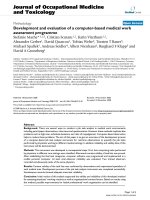35128915 implementation of a FPGA based architecture of prew
Bạn đang xem bản rút gọn của tài liệu. Xem và tải ngay bản đầy đủ của tài liệu tại đây (360.34 KB, 5 trang )
Conference on Electronics and Telecommunication 2010
Bangladesh Electronic Society
Implementation of a FPGA based Architecture of Prewitt
Edge detection Algorithm using Verilog HDL
Mohammad Nazmul Haque
Department of Computer Science & Engineering
Daffodil International University, Dhaka, Bangladesh
e-mail:
This paper pres ents FPGA based architecture for Prewitt edge detection operator. Typical us e of Edge detection is in the
computer v ision, robotics and artificial intelligence sys tem. Currently the image processing algorith ms has been limited to
software imp lementation which is slower due to the limited processor speed. So a dedicated processor for edge detection has
been required which was not possible until advancement in VLSI technology. Now more co mp lex system can be integrated
on a single chip providing a platform to proces s realtime algorith ms on hardware. This arch itecture is imp lemented using
Verilog HDL language and verified by Simulat ion using ModelSim.
Keywords: Edge detection algorithms, hard ware imp lementation, prewitt operators, VLSI, Verilog HDL.
I. Introduction
An edge can be defined as an abrupt change in brightness as we move fro m one pixel to its neighbor in an image. In digital image
process ing, each image is quantized into pixels. In gray-scale each pixel i(x,y) in the image indicates the amplitude of intensity i
of the image in a particular s patial coordinate (x,y). The intensity value 0 represents black, and with 8-bit p ixels, 255 represent
white. An edge is an abrupt change in the intensity (gray scale level) of the pixels. Detecting edges is an important task in
boundary detection, motion detection/estimation, texture analysis, segmentation, and object identification. Human eye can detect
edges very quickly. But it is most difficu lt for machine such as computer vision, robotics etc.
II. Edge Detection
Edge information for a particular pixel is obtained by exploring the intensity of pixels in the neighborhood of that pixel. If all of
the pixels in the ne ighborhood have almost the same brightness, then there is probably no edge at that point. However, if so me of
the neighbors are much brighter than the others, then there is a probably an edge at that point. Measuring the relative brightness of
pixels in a neighborhood is mathemat ically analogous to calculating the derivative of brightness. The image illustrates an example
of Hard and Soft Edges on an image. Brightness values are discrete, not continuous, so we approximate the derivative function.
Different edge detection methods (Prewitt, Laplac ian, Roberts, Sobel and Canny) use different discrete approximations of the
derivative function [1–6].
Figure 1: Types of Edges
III. FP GA Pri mer
In early processes, the edge detection was mainly performed on software due to its large hard ware equip ment and also the
application specific integrated circu its have not gain much advancement. But present researches on programmable devices make it
possible to imp lement edge detection algorith ms on these devices whose design turnaround time varies from few hours to few
days.
During the recent years field programmab le gate arrays (FPGA’s) have beco me the prevailing form of programmable logic [8-12]
in co mparison to previous programmab le devices like co mplex programmable logic devices (CPLD’s) and programmab le array
logic (PA L). FPGA ’s supports sufficient log ic to implement co mp lete systems and subsystems. FPGA exp lo it the increasing
capacity of integrated circuits to provide designers with reconfigurable logic that can be programmed on application specific bas is.
This reconfigurable architecture provides high level of parallelis m. This radically increases flexib ility in both the design process
and the final artifact by permitting one board level design to perform many functions, or to be upgraded in the field.
202
Conference on Electronics and Telecommunication 2010
Bangladesh Electronic Society
IV. Prewitt Edge Detection Algorithm
Prewitt is gradient based edge detection algorithm. The grad ient method looks the edges by finding maximu m and minimu m in
the first derivative of the image. Prewitt algorith m performs a 2-D s patial gradient meas urement on an image. It uses a pair of
3X3 convolution masks, one estimat ing gradient in x-d irection and other in y-direction. Then resultant magnitude is co mputed
fro m the above two gradients . The gradient of the 2-D image i(x,y) at spatial coordinate (x,y) is defined as the vector
I x , y
G x x
I I x , y
G y
y
The magnitude of this vector is
is obtained by:
I I
Gx
G
y
x, y tan 1
G
2
x
G 2y
or
I | Gx | | Gy |
and the direction of the gradient vector
The Prewitt Edge filter is use to detect edges based applying a horizontal and vertica l filter in sequence. Both filters are applied to
the image and summed to form the fina l result. The two filters are basic convolution filters of the form:
1
1
1
-1
0
1
p1
p2
p3
p5
p6
p8
p9
0
0
0
-1
0
1
p4
-1
-1
-1
-1
0
1
p7
a) X-directional convolution mask Gx
b) Y-directional convolution mask Gy
c) Image Neighborhood
Figure 2 : Image Ke rrnel and Pre witt Convolution Masks
Fro m the outputs of these convolution blocks resultant absolute magnitude is co mputed. This magnitude is the final output of the
Prewitt edge detection output. If the X-d irectional convolution mask is placed on p5 pixel then we get:
Gx ( p1 p 2 p3) ( p7 p8 p9)
By plac ing Y-direct ional mask on kernel the new value is given by:
Gy ( p3 p6 p9) ( p1 p4 p7)
The new value of that kernel’s center pixel p5 will be given by:
G | Gx | | Gy |
By applying this procedure to all over the image the edges of x and y direct ion will be gotten.
203
Conference on Electronics and Telecommunication 2010
Bangladesh Electronic Society
12 167 120
1
1
1
50
0
0
0
-1
-1
30
1
23
123 25
-1
Kernel
12 167 120
50
30
1
Gx = (12+167+120)
– (1+123+25)
Gx=150
X-Mask
23
123 25
-1
0
1
-1
0
1
-1
0
1
Kernel
Gy =
(120+23+25)
– (12+50+1)
Gy=105
Y-Mask
G | 150 | | 105 |
255
Figure 3: Convolution Example for Image Pixel
IV. Hardware Architecture of Prewitt Edge Detector Instance
P1, P2, P3, P4, P6, P7, P8 and P9 represent the eight 8bit pixel inputs of the image Kernel to the Prewitt Module. The mod ule
consists of signed subtractors, shift registers and modulus operators. The output of the final adder b lock will be 11 bits (10 bits for
the data as the maximu m va lue of the adder output is 4*255 and the 11th bit as the sign bit). The output data is compared to limit
the value to a maximu m of 255 as the output image is also composed of 8-bit wide pixels. The Prewitt output for one group of
pixels calculated as per |Gx| + |Gy |.
Wid eOr0
Add0
1' h0 --
1 ' h0 --
A[9..0]
p1[8..0]
ab s _gx[10..0 ]
B[9..0]
1' h0 --
+
p2[8..0]
B[10 ..0]
2 ' h0 --
Add 10
+
SEL
11' h001 --
ADDER
SEL
1' h0 - -
DATAA
DATAA
A[10. .0]
B[10. .0]
ADDER
out~[7..0]
Add1
A[10 ..0]
+
8' hFF --
OUT0
DATAB
OUT0
1' h0 --
ou t[8..0]
DATAB
MUX21
ADDER
Add2
1' h0 --
1 ' h0 --
A[9..0]
p7[8..0]
B[9..0]
1' h0 --
+
p8[8..0]
Add3
2 ' h0 --
ADDER
ab s _gy[10..0 ]
Add12
A[1 1..0]
1 ' h1 --
A[10 ..0]
B[10 ..0]
+
B[1 1..0]
+
Add 11
1 ' h1 --
ADDER
ADDER
B[10. .0]
1 ' h0 --
A[9..0]
B[9..0]
1' h0 --
+
p6[8..0]
B[10 ..0]
2 ' h0 --
B[9..0]
1 ' h0 --
+
p4[8..0]
ADDER
+
ADDER
MUX21
Add6
+
ADDER
Add7
A[9..0]
1' h0 --
OUT0
DATAB
A[10 ..0]
ADDER
1' h0 --
B[10..0]
DATAA
+
ADDER
Add5
1' h0 --
A[10..0]
SEL
1' h0 - -
A[10. .0]
11' h001 --
p3[8..0]
MUX21
Add4
B[10 ..0]
2 ' h0 --
Add9
Add8
A[1 1..0]
1 ' h1 --
A[10 ..0]
+
ADDER
B[1 1..0]
+
1 ' h1 --
ADDER
p9[8..0]
Figure 4: RTL View of Prewitt Module
VI. Results
The architecture for Prewitt edge detection operator was imp lemented on VerilogHDL [7–10] and simulat ion on Modelsim Altera
6.4a from Mentor Graphics Corporation. The test images us ed are maximu m 512 p ixels in either height or width with 256 gray
levels. Figure 5 shows the simulation output shown in the convolution examp le of Figure 3. Figure 6 shows output for Prewitt
Edge Detection Hardware module.
204
Conference on Electronics and Telecommunication 2010
Bangladesh Electronic Society
Figure 5: Simulation Output of Prewitt Hardware Module
(i) Input Image
(ii) Edge Image
(iii) Input Image
(v) Input Image
(vi) Edge Image
(vii) Input Image
Figure 6: Hardware Architecture Validation
(iv) Edge Image
(viii) Edge Image
VII. Conclusion and Future Scope
The FPGA based architecture for Prewitt edge detection operator is proposed. This architecture is capable of operating at much
higher speed than processing images on software p latform using high level programming languages like C or C++. This
architecture the result of edge detection can be found out for big images (like of size 1024 × 1024 pixels) in just 7.8 ms. Further
improve ment in speed could be achieved by appending more pipelining stages at decoder and processing blocks level but it may
increase silicon area considerably.
References
[1] Jain, Ani lK. Fundamentals of Digital Image Processing, Prentice-Hall,Inc.
[2] Chanda, B.and Dutta, D. Majumdar. Digital Image Processing and Analysis,Prentice Hall of India.
[3] Gonzalez, Rafael C. and Woods, Richard E. Digital Image Processing, Pearson Education, Inc.
[4] J. F. Canny. A computational approach to edge detection. IEEE Transactions on Pattern Analysis and Machine Intelligence, 8(6):769–798, November 1986.
[5] Pratt,W. K. Digital Image Processing, John Wiley & Sons, Inc.
[6] Heath, Mike, Sarkar, Sudeep, Sanocki, Thomas, and Bowyer, Kevin, Comparison of
Edge Detectors: A Methodology and Initial Study.
[7] Palnitkar, Samir. Verilog HDL-A Guide to Digital Design and Synthesis, Pearson Education.
[8] Chan C.,Mohanakrishnan, Evans, FPGA Implementation of Digital Filters, Proc ICSPAT, 1993
[9] Thomas, Donaldand Moorby, Phil.The Verilog Hardware Description Language,
Kluwe rAcademic Publishers.
[10] Smith, Douglas. HDL Chip Design: A practical Guide for Designing, Synthesizing and Simulating ASICs and FPGAs using VHDL or Verilog ,Doone
Publications.
[11] Jenkins, Jesse H.Designing with FPGAs and CPLDs,Prentice-Hall Publications. F.G.Lorca, L Kessal and D.Demigny. Efficent ASIC and FPGA
implementation of IIR filters for Real time edge detection. International Conference on image processing (ICIP-97) Volume 2. Oct 1997.
[12]Wakerly, JohnF. Digital Design: Principles and Practices, Pearson Education Asia. Muthukumar Venkatesan and Daggu Venkateshwar Rao, Hardware
Acceleration of Edge Detection Algorithm on FPGAs,
205









